NEWHAVEN TELEPHONE EXCHANGES: USED BY MOST - SEEN BY FEW.
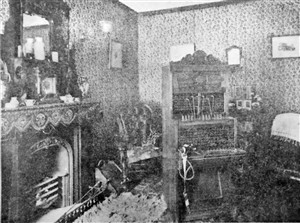
Switchboard similar to Newhaven's first telephone exchange
Courtesy Newhaven Local & Maritime Museum A010P032
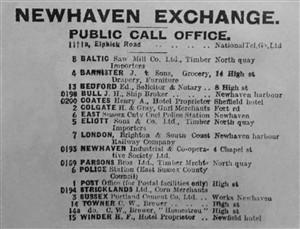
List of early Newhaven telephone subscribers. See text for comment.
Courtesy Newhaven Local & Maritime Museum A047P001
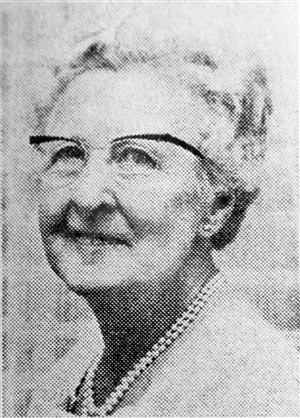
Mrs Lilian Broad, an operator of Newhaven Telephone Exchange in 1914.
Courtesy Newhaven Local & Maritime Museum A047P002
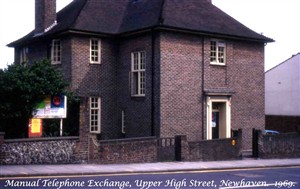
The new purpose-built manual telephone exchange was erected in the Upper High Street in 1930. It was opened in 1931 with a CBS2 manual exchange on the ground floor. This was superseded after the war by a CB10 manual switchboard on the first floor that eventually grew to 15 positions before it closed in 1969. The building was demolished in 1969 to make way for the new Post Office on the same site.
© 1969 Geoffrey Ellis
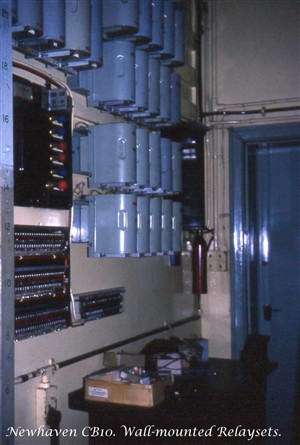
Wall-mounted relaysets in the Apparatus Room of Newhaven Manual Telephone Exchange. One was required for every outgoing junction to Brighton, Eastbourne, Lewes, Peacehaven and Seaford. There were many more out-of-picture. Nearer the camera is an alarm panel with different coloured bulbs, and beneath that, several rows of 'alarm-reporting' fuses that would cause a lamp on the alarm panel above to indicate the location of a blown fuse.
© 1969 Geoffrey Ellis

Operators at work in the 15-position CB10 Manual Exchange Switchroom c.1969. When a subscriber lifted a telephone a lamp lit at the bottom part of the switchboard, and was answered by the operator inserting a 'plug' into the associated 'jack'. To call a subscriber the operator would insert a 'plug' into the appropriate numbered 'jack' on the upper part of the board. This meant that every number had to be within reach of every operator. Every plug in the upper part of the board seen here is a subscriber receiving a call.
Courtesy Newhaven Local & Maritime Museum A047P003
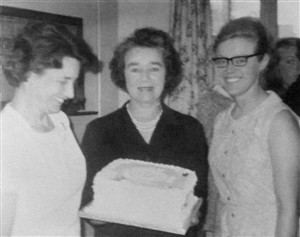
??, Iris Woolmer & Gill Smith, Daytime Supervisors at Newhaven CB10 Exchange in 1969.
Courtesy Newhaven Local & Maritime Museum A047P003

Newhaven Automatic Telephone Exchange in Essex Place, 1969.
© 1969 Geoffrey Ellis
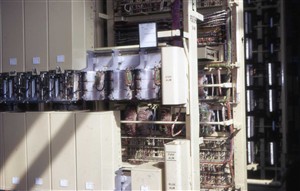
Some of the hundreds of Strowger selectors in Newhaven exchange. At least three such switches were required for every telephone call.
© 1982 Geoffrey Ellis
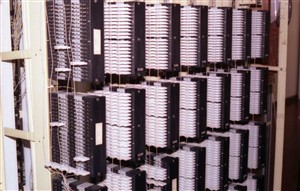
An explanation of how thousands of telephone lines are transferred in a few moments. Each telephone line is tested before transfer day, and then wedged to isolate it from the new exchange. The wedges are later 'strung' together with string as seen here.
© 1982 Geoffrey Ellis
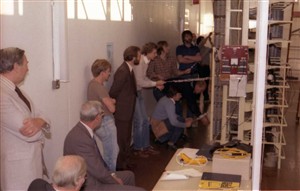
On transfer day, other engineers first disconnect the customers lines from the old exchange (not shown here). Upon command, these engineers then carefully pull the strings to remove the wedges that isolated the customers from the new exchange in a matter of seconds.
© 1982 Geoffrey Ellis
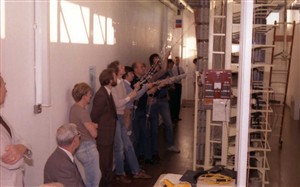
Many hands make light work. Engineering managers watch anxiously over the operation with crossed fingers!
© 1982 Geoffrey Ellis
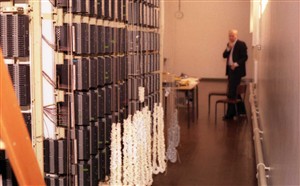
Executive Engineer Bert Luke contemplates the abandoned wedges, their job done, whilst the engineers have moved to the equipment room to ensure that there are no unforeseen problems with the exchange.
© 1982 Geoffrey Ellis
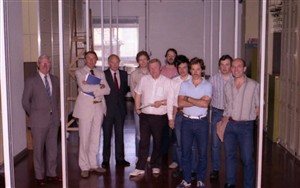
Executive Engineers Gordon Coward, John Whyte, Bert Luke, and Exchange Technical Officers Phil Comben and Alan Smith, with some of the Exchange Construction Engineers involved in the installation, testing, and transfer of the new TXE4 telephone exchange.
© 1982 Geoffrey Ellis
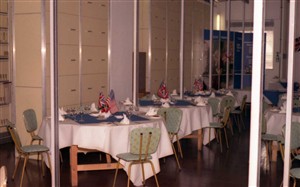
The TXE4 exchange equipment room temporarily converted to become a restaurant, the tables decked with the Stars & Stripes and Union Flags to emphasise the connection with New Haven, Connecticut, U.S.A.
© 1982 Geoffrey Ellis
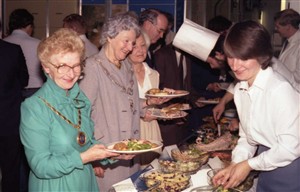
Newhaven Mayor Cllr Jeanette Kennedy formally declared the new exchange open with a self-dialled International call to the Mayor of New Haven, Connecticut, U.S.A. Following the inaugural call, General Manager Kenneth Burling invited the local dignitaries to participate in a celebration lunch that comprised American-style cuisine.
© 1982 Geoffrey Ellis
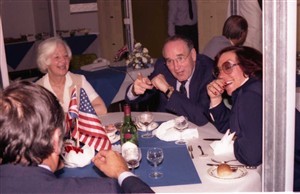
General Manager Kenneth Burling enjoys some congenial conversation with his guests.
© 1982 Geoffrey Ellis
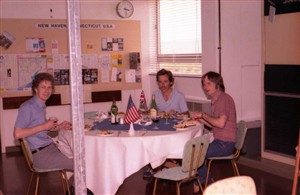
Telephone engineers take time to enjoy some American-style cuisine.
© 1982 Geoffrey Ellis
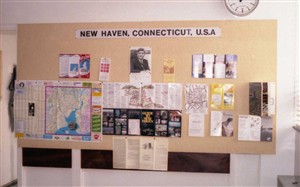
A display of American Tourist Information referring to New Haven, Connecticut, U.S.A. to give added emphasis to the International theme of the transfer.
© 1982 Geoffrey Ellis
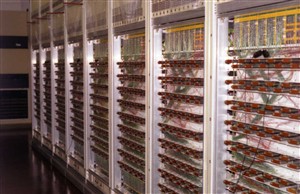
Racks of TXE4 CLI (Calling Line Identification) equipment. The silence of the digital exchange is un-nerving compared to Strowger automatic exchanges where engineers were sometimes known to wear ear-defenders!
© 1982 Geoffrey Ellis
A Century of Telecommunication in Newhaven
By Geoffrey Ellis
The 20th Century saw greater advances in telecommunications than ever before, contributing greatly to what today we call ‘the global village’. Today’s generations are being born into a world where self-dialled telephone calls to any developed country in the world, even using a mobile phone, are commonplace. But it was not always like that…
Take Newhaven for example. Newhaven’s first telephone exchange was a very ornate affair like the one shown here, that was installed in the parlour of an ordinary town house, 1a Elphick Road, by the National Telephone Company Ltd, c.1906. A switchboard like this could cater for up to 100 subscribers, with maybe a few junctions to nearby towns, say Lewes, Seaford and Brighton. Pioneering installations involved a considerable initial investment, and at first the telephone service was therefore affordable only by businesses, hotels, the local constabulary and the very well heeled. The telephone network in those days worked on the ‘magneto system’, where calls began and ended with a few turns on a hand-generator to send a signal to the exchange to attract the operator’s attention; and each subscriber’s instrument required a box of Leclanché Cells (wet batteries) to work the transmitter (carbon microphone).
An early list of Newhaven telephone subscribers records eighteen subscribers and one ‘Public call office’. Most have two-digit numbers, but four are prefixed with ‘01’, and one is prefixed with ‘02’. The significance of these prefixes is not known.
In 1912 the General Post Office (GPO) became the monopoly supplier of the telephone service and took over the National Telephone Company Ltd and the whole private sector telephone service in the UK, except for Hull (that still remains private in 2010). There were then 27 subscribers in Newhaven. All telephone switchboards and their operators then came under the jurisdiction of the local Postmaster(s). Mrs Lilian Broad, a local telephone operator in 1914 spoke of the inadequacies of the system during World War I. (Newhaven was the principal port engaged in transporting vast quantities of personnel and munitions to France during WWI).
By the early 1930s, Newhaven’s early switchboard was woefully outdated and inappropriate for the growing number of local subscribers. A purpose-built telephone exchange building was erected in the High Street with three new switchboards on the ground floor, and a resident caretaker-operator’s apartment on the first floor. It was brought into service in 1931, when it was recorded that there were 120 subscribers. These switchboards worked on the Common Battery Signalling system (CBS2) that no longer required each subscriber to use a hand-generator to call the operator; however there was still a need for each subscriber to have a battery box to work their telephone’s transmitter. The number of subscribers increased as the telephone became more popular and affordable, and the numbering scheme expanded to three digits.
At the end of WWII the CBS2 switchboards were replaced by a Central Battery system (CB10) that had a larger numbering capacity and employed improved technology that dispensed with the need for subscribers to maintain their individual battery boxes. (These were a frequent source of trouble as they needed regular attention by the subscriber to top-up the electrolyte in the wet cells, but invariably ‘forgotten’). The new switchboards were installed in a room on the first floor of the telephone exchange, and the vacated downstairs area was occupied by the extra engineering equipment and testing facilities now required.
By a remarkable coincidence at this time, the resident nighttime caretaker-operator’s name was Mrs Knight; whereas the daytime supervisor who travelled daily by train from Lewes was Miss Day!
As the years passed, all the large manual telephone exchanges around the country were converted to automatic working. The telephone service network became increasingly more automated, to the point where Subscriber Trunk Dialling (STD) was introduced in the late 1950s. This provided an impetus to convert all the remaining smaller manual telephone exchanges to automatic working to enable all subscribers to take full advantage of the latest technology.
Thus it was that a new purpose-built automatic telephone exchange building was constructed in Essex Place, Newhaven, and equipped with standard Non Director Strowger apparatus with a four-digit numbering scheme and a capacity for 2400 subscribers. This was brought into service on Wednesday 25 June 1969 by which time the number of subscribers had risen to 1466. The existing three-digit numbers were simply prefixed with 2 or 3 to become 4-digit numbers.
In 1969 the STD prefix for Newhaven was 0-7912; but as time passed, this was later changed, first to 0-273, and then 01-273 to cater for the introduction of Subscriber International Dialling and the previously unanticipated explosive growth of the mobile telephone.
The Strowger ‘step-by-step’ automatic telephone exchange served the town well for many years whilst some new technologies were developed. These new technologies, known as Crossbar, TXE4 and System ‘X’, used entirely different principles of operation. For a while there was a period when all three systems were being ‘operationally tested’ to determine their respective merits for costs, performance, and reliability. Seaford got a Crossbar exchange, and Newhaven got a TXE4 all-digital exchange (one of eleven in the Brighton Telephone Area).
In June 1982 Newhaven Strowger exchange was transferred to TXE4 with much publicity. The town’s Mayor Cllr Jeanette Kennedy formally opened the new exchange with an inaugural self-dialled transatlantic telephone call to the Mayor of New Haven, Connecticut, U.S.A. following the transfer.
With the opening of the new TXE4 exchange the numbering range was changed to 6 digits by prefixing all existing 4-digit numbers with 51, and new numbering ranges starting 61 & 62 were introduced to allow for an increased demand for new lines, fax machines, etc. resulting from continuing local domestic and industrial development in the town and local villages.
In the 1990s the government issued a White Paper called ‘Competition & Choice’ that broke the BT landline monopoly. This enabled customers to acquire telecommunications services from a host of new Communications Companies, and spawned competing providers offering a variety of tariffs, all vying with each other to produce the most consumer-attractive deals.
Today’s Newhaven telephone exchange is equipped with some 10,000 lines to serve customers in Newhaven and its surrounding villages of Denton, Piddinghoe, South Heighton, and Tarring Neville by Service Providers such as BT, Orange, Post Office, Sky, TalkTalk, Tiscali, Virgin and others, - even Supermarkets! All of these companies offer Broadband Internet access by which means gratuitous worldwide person-to-person video calls are possible using a computer and a Voice-Over-Internet-Protocol program such as Skype or Buster (other VOIP programs are available).
That, in a nutshell, is the 20th Century story of telephonic/digital communication in Newhaven. One can but wonder what the 21st Century will produce. Happen I will have to leave that for somebody else to record; at least they will have these facts to build upon. Come back in 2110.